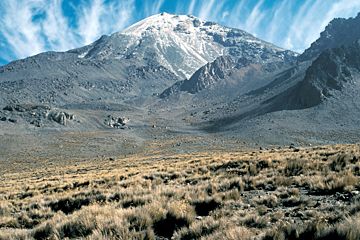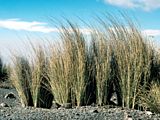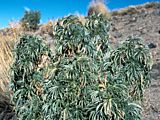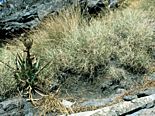Mexican volcanoes
Above the
Pinus hartwegii
treeline at sharply 4000 m elevation, the alpine vegetation on the Mexican volcanoes is
represented by tall tussock grasses and herb fields. In order to improve fodder these
grasslands are regularly burned. Rocky outcrops not reached by fire host refugia of herbaceous
and scrub flora.

1 - Pico de Orizaba, 5610 m
1 - Pico de Orizaba, 5610 m

2 - Tough alpine tussock grasses are regularly burned (4050 m).
2 - Tough alpine tussock grasses are regularly burned (4050 m).

3 -
Lupinus sp.
(Fabaceae), in March, early season (Pico de Orizaba, 4100 m).
3 -
Lupinus sp.
(Fabaceae), in March, early season (Pico de Orizaba, 4100 m).
4 -
Eryngium af. proteiflorum
(Apiaceae, left) and small size tussock grasses (right) (Iztaccihuatl, 4000 m). Note the
dead leaf curling similar to grass heath in the
Alps
or
New Zealand.

7 -
Echevaria sp.
(Crassulaceae) (Iztaccihuatl, 4030 m). A common leaf succulent rosette plant which
performs crassulacean acid metabolism (CAM).
7 -
Echevaria sp.
(Crassulaceae) (Iztaccihuatl, 4030 m). A common leaf succulent rosette plant which
performs crassulacean acid metabolism (CAM).

8 -
Mahonia sp.
(Berberidaceae), an evergreen shrub (Iztaccihuatl, 4030 m).
8 -
Mahonia sp.
(Berberidaceae), an evergreen shrub (Iztaccihuatl, 4030 m).







